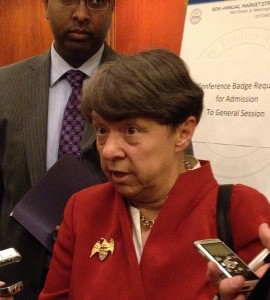The head of the Securities and Exchange Commission says a deeper understanding is needed about the boom in high frequency trading, the increasing amount of dark pool trading and other changes.
The complexity of trading after years of technological and organizational evolution requires an examination of equity market structure to improve functionality on all levels, SEC Chair Mary Jo White said before a conference of the Security Traders Association on Wednesday.
White pointed to existing problems within the market such as a drop in U.S.-listed businesses that require regulatory attention immediately to expand.

Securities and Exchange Commission Chairman Mary Jo White addresses reporters after a speech to stock traders. KATIE PERALTA/MEDILL
“Our market structure should inspire confidence in investors and companies that they will be treated fairly and that the system will work efficiently,” White said.
Market structure, ranging from how the market is organized to how technology influences trade, has been one of White’s top priorities since taking over at the SEC in April. White emphasized a return to the fundamentals when considering the complex market structure.
“Our concern is that as the complexity of our market structure has grown, so too has the complexity of diagnoses offered and solutions proffered,” White said.
To better understand complex markets, the chief called on audience members to challenge assumptions of the current market structure, whose “one-size-fits-all” mold often fails small companies.
“For the most part, market rules and trading mechanisms are today the same regardless of wide variations in the size of public companies,” White said.
The Regulation National Market System, a set of rules created by the SEC in 2005, was intended to foster market fairness and competition but has been blamed for creating complexity in the public equity market.
“Reg NMS was supposed to help the little guy— help the individual investor— and that individual investor has been pushed to the bottom of the pile,” said John Calicchio, chief operating officer at Euro Pacific Capital before White’s talk. Calicchio said he hopes White’s SEC operation continues to focus on integrity and structure.
An often overlooked element to making sense of market structure, according to White, is making decisions based on empirical evidence rather than relying on anecdotes.
“Data alone, of course will, not reconcile all of the differing and often conflicting views on market structure, but the right data can be used to test hypotheses, identify and eliminate potential problems and narrow and focus the debate on the real issues,” she said.
As a part of this effort in understanding is a soon-to-be-launched public website designed to share data, research and analysis. Metrics and trends on the site, White said, would be based on analyses of market information and data analysis system (MIDAS) records from the past year.
“Not only are we making these analyses available, we’re making them accessible,” White said of the site, which could be available as early as next week. “With the click of a mouse, results will be available in clear, easy-to-read charts and graphs.”
The focus on data resonated with Randy Williams, senior vice president of investor relations and communications at BATS Global Markets, Inc. “We’re certainly supportive of a data-driven approach. We’ve said that all along,” he said. “We liked what the chair man had to say in her speech and look forward to continuing to work with her and other regulators in the rest of the industry.”
